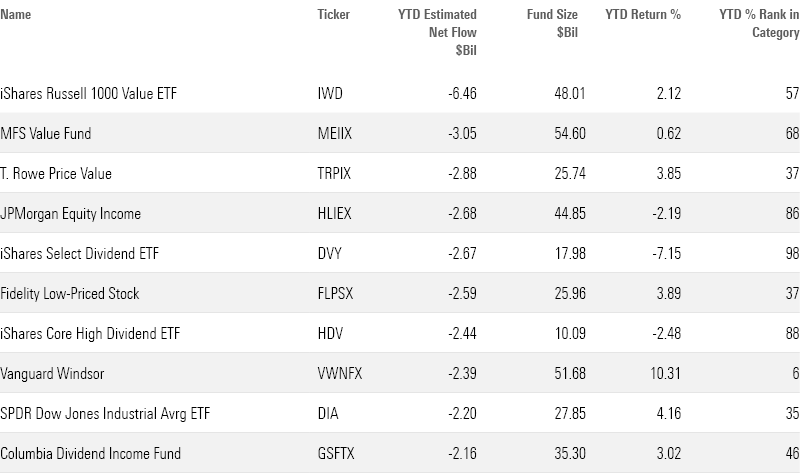Large-Value Funds on Track for Worst-Ever Year of Outflows
Outflows from passive funds exacerbate the category’s woes.

The bad news keeps coming for funds focused on large-value stocks this year. Investors are on track to pull a record amount of money from value funds in 2023.
Amid a year of poor performance relative to growth and blend funds, through September 2023, large-value funds have recorded $59.7 billion in outflows. That far outstrips the previous record set in 2020, when large-value mutual funds and ETFs lost $44.6 billion.
Among the large-value funds with the heaviest outflows have been dividend strategies, whose stocks are now seeing strong competition from high-yielding bonds for investor dollars.
This exodus ended a two-year reprieve for large-value funds. The category collected $60.1 billion in 2021 and $41.4 billion in 2022, led by strong investor interest in index-tracking value funds.
Large-Cap Fund Flows
Passive Value Funds See Outflows
Both active and passive value fund strategies are seeing outflows. Passive large-value funds have seen $21.6 billion leave, while active large-value funds have lost $38.1 billion. Of the 10 funds with the biggest outflows in the year to date, four are passively managed. This marks a change in fortunes. In 2020, most of the new money flowing into large-value funds went to passive strategies, while active funds suffered investor withdrawal. The $98.8 billion Vanguard Value Index VIVAX alone gathered $13.6 billion in 2022. This year, $2 billion has exited the fund.
In 2023, among passively managed funds, the $48 billion iShares Russell 1000 Value ETF IWD has experienced the largest outflows, with $6.5 billion exiting through September. Among active strategies, the $25.7 billion T.Rowe Price Value TRIPX has seen the most leave, with $2.9 billion in outflows.
Yearly Large Value Fund Flows
Large-Value Fund Performance
Prior to their turnaround in 2021, large-value funds experienced outflows for years, as their returns lagged far behind those of large-growth and large-blend stock funds. Large-value funds underperformed large-growth funds for four consecutive years, from 2017 through 2020. In 2020 the story was particularly dramatic, as a handful of technology stocks led the U.S. stock market’s recovery from its March pandemic-driven lows. Large-growth funds beat value by the widest performance margin ever on an annual basis; the average large-growth fund gained 35.9%, while the average large-value fund advanced only 2.9%.
The performance trend shifted as inflation ran hot and investors anticipated that the Federal Reserve would need to start raising interest rates. Large-value funds outperformed large-growth funds in 2021 and 2022. Last year, the average large-value fund lost 5.9%, while the average large-growth fund fell 30%.
Investors often believe higher interest rates disproportionately hurt growth stocks because they are projected to earn money further out into the future than value stocks. Additionally, higher interest rates make their future earnings worth less.
But during 2023, a handful of growth stocks—mostly in the technology and communication services sectors—have again powered the U.S. market higher, as investors began anticipating that the Fed would stop raising rates and the artificial intelligence boom fueled rallies in some big-name tech stocks. The average large-growth fund is up 22.3% this year, while the average large-value fund has advanced only 2.5% through Oct. 17.
Annual Returns
Dividend funds in particular have taken losses as the higher interest rates offered by bonds make their payouts less appealing. Half of the 10 large-value funds with the greatest outflows have a dividend focus.
The $18 billion iShares Select Dividend ETF DVY is down 7.2% this year, putting it in the 98th percentile of large-value funds. Investors have pulled $2.7 billion from the fund. Similarly, the $44.9 billion JPMorgan Equity Income HLIEX has shed $2.7 billion. It’s down 2.2%, putting it in the 86th percentile of large-value funds.
Performance doesn’t seem to be the only factor at play. The $51.7 billion Vanguard Windsor VWNFX is up 10.3% so far in 2023, putting it in the 6th percentile of large-value funds. Still, investors have pulled $2.4 billion from the fund.
Value Funds With the Largest Outflows

Correction: A previous version of this article stated that active large-value fund outflows the for year-to-date period through September totaled $28.1 billion. This has been corrected to $38.1 billion.
The author or authors do not own shares in any securities mentioned in this article. Find out about Morningstar’s editorial policies.

/s3.amazonaws.com/arc-authors/morningstar/8b2e267c-9b75-4539-a610-dd2b6ed6064a.jpg)
/cloudfront-us-east-1.images.arcpublishing.com/morningstar/GJMQNPFPOFHUHHT3UABTAMBTZM.png)
/cloudfront-us-east-1.images.arcpublishing.com/morningstar/ZYJVMA34ANHZZDT5KOPPUVFLPE.png)
/cloudfront-us-east-1.images.arcpublishing.com/morningstar/LDGHWJAL2NFZJBVDHSFFNEULHE.jpg)
:quality(80)/s3.amazonaws.com/arc-authors/morningstar/8b2e267c-9b75-4539-a610-dd2b6ed6064a.jpg)